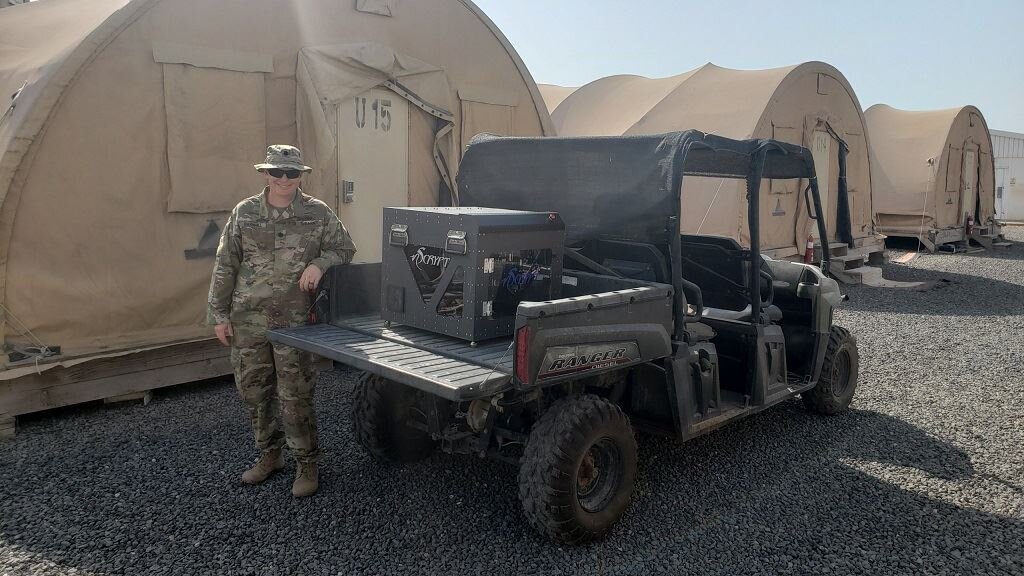![The nScrypt ABAT 3D printer is ruggedized and ready to roll [Image: nScrypt]](https://fabbaloo.com/wp-content/uploads/2020/05/nscryptruggedized1a_img_5eb08f78d1b84.jpg)
Biofabrication gets a boost with a successful pilot program in an austere environment.
Earlier this year, nScrypt announced its ruggedized bioprinter, the Austere BioAssembly Tool (ABAT), was gearing up for in-the-field service.
This week they’ve announced early success in taking ABAT for a test run in 3D printing medical products in rough conditions — such as those endured in military deployments.
Military Biofabrication
Why does the military want a ruggedized 3D printer?
On top of the obvious (ruggedized everything), the armed forces around the world are increasingly exploring 3D printing for in-the-field solutions to a variety of problems. Supplies, spare parts, even weapons — so why not also medical supplies?
The nScrypt machine pilot came about with The Geneva Foundation and the Uniformed Services University (USU) 4-Dimensional Bioprinting, Biofabrication, and Biomanufacturing Program (4D Bio3), in support of the U.S. Military, along with RoosterBio. Quite the multi-disciplinary collaboration.
The project is focused, they say, on “the biofabrication of medical products in an austere military environment, with the goal of advancing future next-generation treatments for the Nation’s deployed warfighters.” They continue:
“Advances in 3D printing and biofabrication have the potential to provide unprecedented benefits for the warfighter, including perhaps the direct repair or replacement of damaged tissues. This is especially powerful when achieved in austere conditions; warfighters injured in the field could have personalized health solutions immediately fabricated onsite.”
Ruggedized ABAT
The ABAT deployment is part of the 4D Bio3 Fabrication in Austere Environments (Fab AE) Program, which is testing and validating 3D printing feasibility for personalized healthcare.
The system has shown itself to work with polymers, electronic components, and biologics. Materials tested also included Ready To Print (RTP) human mesenchymal stem/stromal cells (hMSCs) from RoosterBio for bioprinting work. These, the collaborators note, enable “austere printing in a resource-limited setting as these are the only cells that allow for same-day bioprinting capabilities.”
Four biofabrication projects are highlighted from the pilot test:
-
3D printing of #3 scalpel handle and hemostat
-
3D printing of bioactive bandages
-
3D printing of a surgical model of T9 vertebrae
-
3D bioprinting of a meniscus
![3D printed bioactive bandage [Image: nScrypt]](https://fabbaloo.com/wp-content/uploads/2020/05/nscryptruggedized2a_img_5eb08f792f16d.jpg)
They represent a good variety of different types of projects the ABAT could be faced with in real-world settings, with tools, healing aids, anatomical models, and actual bioprinting all seeing great potential for next-generation care of personnel.
Each of the projects highlights aspects of 3D printing as well as on-demand manufacture. The bandages, for example, have a 3D printed layer of hydrogel with antibiotics that feature a slow-release quality to suppress bacterial infection — for a few days. 3D printing the bandage was done “within five minutes,” which is a pretty solid time turnaround for days-long wound protection. Such relatively quick timing was seen across the board, with surgical tools 3D printed within an hour and a half — and, importantly, these tools are all able to be steam-sterilized to further reduce infection risk.
While the vertebrae model was not itself an implant, anatomical models are proving of great value in medical treatment to help both medical personnel and patients understand exactly what’s at play in individual cases.
For its part, the bioprinted meniscus seems to have not been for in-patient use, but served again as an example of the possible. 3D printed using live MSCs and a hydrogel scaffold, the meniscus represents “the first demonstration of cyber manufacturing being used whereby complex designs are transmittable to remote austere location for production.”
It is worth noting that the 3D files for both vertebrae and meniscus were sent to the undisclosed location of the ABAT. Both were developed from medical data seemingly already on-hand. Creating files in the field for those also in the field will add another layer of consideration, but as a proof of concept the fact that these were able to be created and meet desired quality points remains solid.
What’s Next?
The success of the pilot project is another step in the journey to true on-demand point-of-care healthcare.
But that doesn’t mean it’s going standard on every deployment anytime soon.
Success is good, but as with any potentially critical healthcare introduction, it’s going to take a lot more testing to ensure compliance and viability, not to mention logistics.
The announcement notes that ABAT represents a next-generation solution — so as with so much in bioprinting in particular, this might indeed be a development more suited for the actual next generation of deployments rather than something current service members might expect to start popping up.
Via nScrypt and The Geneva Foundation

